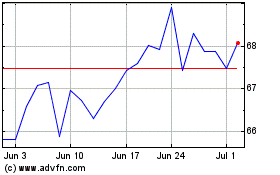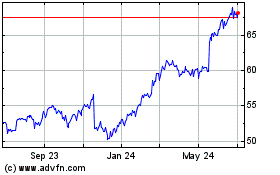Wal-Mart Names New Finance Chief -- 2nd Update
October 09 2015 - 11:50AM
Dow Jones News
By Ezequiel Minaya
Wal-Mart Stores Inc. said Friday it has tapped a new chief
financial officer hailing from its international division, as the
world's largest retailer looks to stoke its top and bottom
lines.
The company said 47-year-old Brett Biggs will take over for
current Financial Chief Charles Holley, who will retire as CFO at
the end of the year and then remain for another month to help with
the transition. Mr. Holley is 59 years old.
Wal-Mart also named Steve Bratspies as chief merchandising
officer for U.S. stores, effective Oct. 19. In that spot, Mr.
Bratspies will oversee all merchandise categories across the more
than 4,500 U.S. stores. He will continue to report to Greg Foran,
Wal-Mart's U.S. president.
Mr. Bratspies was executive vice president of food for Wal-Mart
U.S. Charles Redfield will replace him in that position, the
retailer said.
Mr. Biggs, meanwhile, has served as chief financial officer of
Wal-Mart International since 2014. Before his current role, he
served as chief financial officer of Wal-Mart U.S. from 2012 until
2014, and as senior vice president of Sam's Club operations from
September 2010 to January 2012.
"Brett is a strong leader whose broad experience uniquely
qualifies him to lead our finance and strategy areas," said Doug
McMillon, Walmart's Chief Executive. "Having had a variety of
important roles in all three of Wal-Mart's business segments, Brett
is well prepared."
Mr. Holley had been CFO since late 2010 and has spent more than
20 years with the company. Before assuming his current role, he was
executive vice president of finance and treasurer, and also served
as chief risk officer and controller.
From 1994 through 2002, Mr. Holley held several roles in Walmart
International, including being CFO for the division. Mr. McMillon
said Mr. Holley has transformed Wal-Mart's finance function into
one "that is both strong and deep."
In the quarter ended July, sales at Wal-Mart's international
operations dipped nearly 10% to $30.6 billion as foreign-exchange
volatility dragged the top line. During the same period, sales in
the U.S. segment edged up 4.8% to $74 billion.
Wal-Mart is engaged in retail and wholesale operations in the
U.S., as well as Brazil, China, India, Japan, Mexico, the U.K. and
several other countries.
Faced with increased competition, Wal-Mart is spending heavily
to make its stores more convenient places to shop, adding staffing
to speed checkout lines and make sure shelves are better stocked.
In April, the company raised its minimum hourly wage paid to $9 and
said it would boost pay to $10 for many employees by February.
The company's investments on behalf of customers have crimped
profits but helped reverse a sales slump: Wal-Mart is drawing more
shoppers who spend slightly more during their visit.
In a conference call following the release of second-quarter
results, Mr. McMillion said the company was in a period of change
but noted that it had rebounded from similar circumstances
before.
In addition to higher wages, Wal-Mart's profit has been squeezed
by currency fluctuations and lower-than-expected reimbursements for
its pharmacy business.
Write to Ezequiel Minaya at ezequiel.minaya@wsj.com
Subscribe to WSJ: http://online.wsj.com?mod=djnwires
(END) Dow Jones Newswires
October 09, 2015 11:35 ET (15:35 GMT)
Copyright (c) 2015 Dow Jones & Company, Inc.
Walmart (NYSE:WMT)
Historical Stock Chart
From Mar 2024 to Apr 2024

Walmart (NYSE:WMT)
Historical Stock Chart
From Apr 2023 to Apr 2024
